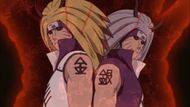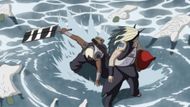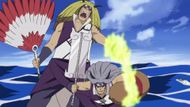Naruto has a range of intriguing characters from the ninja world. Among them are Ginkaku and Kinkaku, the Gold and Silver Brothers. The two brothers appear in the Fourth Great Ninja War Arc. Their story is a short but entertaining one, with powers and abilities that make them some of the strangest villains we see in the franchise.
Kinkaku and Ginkaku hail from the Hidden Cloud Village and have some sort of direct relation to the Sage of Six Paths. They lived in the time before the Naruto series, during the time of the second Hokage, Tobirama Senju. But they were revived by Kabuto as a part of the reanimation jutsu during the Fourth Great Ninja War. Naruto then describes how the Gold and Silver Brothers acquired their abilities under odd circumstances.
They became popular when they attempted to capture the Nine-Tails, also known as Kurama. But instead of capturing it, they were swallowed whole by the beast. Most people would have died inside the Nine-Tails, but Kinkaku and Ginkaku survived for two weeks. While inside, they ate the flesh of the Nine-Tails to stay alive. Because of this, they absorbed some of Kurama’s chakra and gained powers similar to a Jinchuriki.

The powers they gained from the Nine-Tails made them more capable. Both brothers could enter a partial Tailed Beast Mode, which gave them enhanced strength, speed, and durability. Unlike normal Jinchurikis, who could enter more than one complete transformation, they only had access to version 1 and 2 forms. This made them stronger and more difficult to deal with, even against the skilled shinobi in Naruto.
They could control their chakra well and use the Nine-Tails’ power to fight impressively. The Gold and Silver Brothers in Naruto possessed the treasures of the Sage of Six Paths. The Sage of Six Paths once possessed these tools, which were so powerful that it was said that if used well, they could surpass the Five Kage.
The weapons were normally passed down in Kumogakure until the brothers got their hands on them. The weapons were so powerful always resulted in backlash after use. But because of their normal chakra reserves plus the nine-tails’, they did not have that problem. Kinkaku and Ginkaku became even more threatening in combat because of these weapons.

Kinkaku and Ginkaku were very strong, and many people were scared of them. In the past, they attempted a coup in their village, proving how dangerous and rebellious they were. They almost killed the Second Raikage and the Second Hokage during the attack.
Even though they are not in Naruto for long, they still play an important part in the story. The brothers demonstrate the dangers of greed and uncontrollable power. It also sheds light on a story that takes place before the Naruto timeline. We have seen plenty of people from the Hidden Leaf’s past, but we rarely get a look at other villages. This gives the Hidden Cloud a more robust narrative.
Naruto also teaches that teamwork can beat and surpass great odds, no matter how strong you are. Kinkaku and Ginkaku required Darui, Ino, and two other shinobi to be taken down. That lesson is one that is repeated over and over again throughout the series, and a large reason why Naruto himself becomes so powerful. He is never alone and depends on all the people he meets along the way.

In the Fourth Great Ninja War, Naruto presents a different kind of enemy to the fans. Kabuto Yakushi revived many powerful ninjas with the Reanimation Jutsu during the Fourth Great Ninja War, including the Kinkaku and Ginkaku. He does so to increase his numbers and sap the strength of the Allied Shinobi Forces. The brothers fight bravely for Kabuto, using their Nine-Tails chakra and treasured tools to cause heavy damage.
The Treasured Tools in Naruto
Naruto illustrates how these tools work during the Fourth Great Ninja War. One of their tools, the Kokinjo, has the ability to pull out the word soul of anyone who has touched it. After it is pulled out, the Shichiseiken, a broadsword, is used to cut the word soul. The Benihisago then absorbs said word soul into itself. After all the steps are over, if the attacked person says the word they have said the most during their life, they will be sucked and trapped in the Benihisago.
The fourth weapon in their possession is the Bashosen. It is a big fan that has the ability to create all five basic types of chakra elements. The brothers used them against the Allied Shinobi Forces, making it very hard for the alliance to fight back. The user just thinks of a command, and as they wave the fan, it generates the thought elements. In the anime, the fan can also block attacks like a shield.

Darui, a shinobi from the Hidden Cloud Village, played a big role in the battle against them. With great effort, Darui and his team managed to seal Ginkaku using the Benihisago. Kinkaku, however, was harder to stop because he could fully transform into his Tailed Beast Mode. Eventually, the Allied Forces were able to trap him in the Kohaku no Johei, another Treasured Tool as well. But it took a lot of teamwork and strategy to succeed.
Conclusion
In the end, Naruto uses the story of the Gold and Silver Brothers to add more history to the shinobi world. Their special abilities, tools, and aggressive behaviors create memorable characters. Even though they were enemies, their tale showcases several important lessons that Naruto Uzumaki discovers throughout his adventure.
